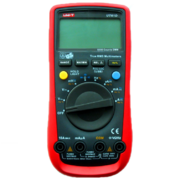Difference between revisions of "UNI-T UT61D"
Jump to navigation
Jump to search
Uwe Hermann (talk | contribs) m |
|||
| (9 intermediate revisions by 2 users not shown) | |||
| Line 1: | Line 1: | ||
[[File:Uni t ut61d device. | {{Infobox multimeter | ||
| image = [[File:Uni t ut61d device.png|180px]] | |||
| name = UNI-T UT61D | |||
| status = supported | |||
| source_code_dir = uni-t-dmm | |||
| counts = 6000 | |||
| categories = CAT II (600V) / CAT III (300V) | |||
| connectivity = [[Device_cables#UNI-T_UT-D02|RS232]] / [[Device_cables#UNI-T_UT-D04|USB]] | |||
| measurements = voltage, current, resistance, capacitance, frequency, duty cycle, diode, continuity | |||
| features = autorange, true-rms, data hold, min/max, rel, bargraph, backlight | |||
| website = [http://www.uni-trend.com/UT61D.html uni-trend.com] | |||
}} | |||
The | The '''UNI-T UT61D''' is a 6000 counts, CAT II (600V) / CAT III (300V) handheld digital multimeter with RS232 or USB connectivity. | ||
See [[UNI-T UT61D/Info]] for more details (such as '''lsusb - | See [[UNI-T UT61D/Info]] for more details (such as '''lsusb -v''' output) about the device. | ||
== Hardware == | == Hardware == | ||
* | '''Multimeter''': | ||
* '''Multimeter IC''': [[Multimeter_ICs#Fortune_Semiconductor_FS9922-DMM4|Fortune Semiconductor FS9922-DMM4]] ([http://www.ic-fortune.com/upload/Download/FS9922-DMM4-DS-11_EN.pdf datasheet]) | |||
* '''Low-power True RMS-to-DC converter''': [http://www.analog.com/en/special-linear-functions/rms-to-dc-converters/ad737/products/product.html Analog Devices AD737] ([http://www.analog.com/static/imported-files/data_sheets/AD737.pdf datasheet]) | |||
* '''Crystal''': 4MHz (markings: "ROSON 3.999FSHN") | |||
* '''Fuses''': 10A/240V and 1A/240V (HRV fuses) | |||
'''RS232 cable''': | |||
See [[Device cables#UNI-T_UT-D02]]. | |||
'''USB cable''': | |||
See [[Device cables#UNI-T_UT-D04]]. | |||
== Photos == | == Photos == | ||
| Line 14: | Line 37: | ||
<gallery> | <gallery> | ||
File:Uni-t ut61d package contents.jpg | File:Uni-t ut61d package contents.jpg|<small>Package contents</small> | ||
File:Uni t ut61d device.jpg | File:Uni t ut61d device.jpg|<small>Device, front</small> | ||
File:Uni-t ut61d device back.jpg | File:Uni-t ut61d device back.jpg|<small>Device, back</small> | ||
File:Uni-t ut61d battery.jpg | File:Uni-t ut61d battery.jpg|<small>Battery</small> | ||
File:Uni-t ut61d device open1.jpg | File:Uni-t ut61d device open1.jpg|<small>Device open 1</small> | ||
File:Uni-t ut61d device open2.jpg | File:Uni-t ut61d device open2.jpg|<small>Device open 2</small> | ||
File:Uni-t ut61d device open3.jpg | File:Uni-t ut61d device open3.jpg|<small>Device open 3</small> | ||
File:Uni-t ut61d device open4.jpg | File:Uni-t ut61d device open4.jpg|<small>Device open 4</small> | ||
File:Uni-t ut61d pcb front.jpg | File:Uni-t ut61d pcb front.jpg|<small>PCB, front</small> | ||
File:Uni-t ut61d pcb back.jpg | File:Uni-t ut61d pcb back.jpg|<small>PCB, back</small> | ||
File:Uni-t ut61d pcb front top.jpg | File:Uni-t ut61d pcb front top.jpg|<small>PCB front, top</small> | ||
File:Uni-t ut61d pcb front middle.jpg | File:Uni-t ut61d pcb front middle.jpg|<small>PCB front, middle</small> | ||
File:Uni-t ut61d fs9922-dmm4.jpg | File:Uni-t ut61d fs9922-dmm4.jpg|<small>FS9922-DMM4</small> | ||
File:Uni-t ut61d ad737j.jpg | File:Uni-t ut61d ad737j.jpg|<small>AD737J</small> | ||
File:Uni-t ut61d crystal.jpg | File:Uni-t ut61d crystal.jpg|<small>Crystal</small> | ||
File:Uni-t ut61d testadapter1.jpg | File:Uni-t ut61d testadapter1.jpg|<small>Testadapter 1</small> | ||
File:Uni-t ut61d testadapter2.jpg | File:Uni-t ut61d testadapter2.jpg|<small>Testadapter 2</small> | ||
File:Uni-t ut61d testadapter3.jpg | File:Uni-t ut61d testadapter3.jpg|<small>Testadapter 3</small> | ||
File:Uni-t ut61d lcd.jpg|<small>LCD</small> | File:Uni-t ut61d lcd.jpg|<small>LCD</small> | ||
</gallery> | </gallery> | ||
| Line 37: | Line 60: | ||
'''RS232 cable''': | '''RS232 cable''': | ||
See [[Device cables#UNI-T_UT- | See [[Device cables#UNI-T_UT-D02]]. | ||
'''USB cable''': | '''USB cable''': | ||
| Line 45: | Line 68: | ||
== Protocol == | == Protocol == | ||
See [[Multimeter_ICs#Fortune_Semiconductor_FS9922-DMM4]] for the DMM IC protocol. Depending on the cable, additional transport-specific decoding is needed, though. | |||
== Resources == | == Resources == | ||
* [http://www.uni-trend.com/manual2/UT61English.pdf Manual] | |||
* [http://www.uni-trend.com/Web%20site/DMM%20Software/UT61D%20setup.exe Vendor software] | |||
* [https://perhof.wordpress.com/category/computing/linux/ perhof: Uni-T UT61D for Linux] (also: [http://dl.dropbox.com/u/20603229/published/ut61d.zip ut61d.zip]) | * [https://perhof.wordpress.com/category/computing/linux/ perhof: Uni-T UT61D for Linux] (also: [http://dl.dropbox.com/u/20603229/published/ut61d.zip ut61d.zip]) | ||
[[Category:Device]] | [[Category:Device]] | ||
[[Category:Multimeter]] | [[Category:Multimeter]] | ||
[[Category:Supported]] | |||
Latest revision as of 20:31, 31 December 2013
 | |
| Status | supported |
|---|---|
| Source code | uni-t-dmm |
| Counts | 6000 |
| IEC 61010-1 | CAT II (600V) / CAT III (300V) |
| Connectivity | RS232 / USB |
| Measurements | voltage, current, resistance, capacitance, frequency, duty cycle, diode, continuity |
| Features | autorange, true-rms, data hold, min/max, rel, bargraph, backlight |
| Website | uni-trend.com |
The UNI-T UT61D is a 6000 counts, CAT II (600V) / CAT III (300V) handheld digital multimeter with RS232 or USB connectivity.
See UNI-T UT61D/Info for more details (such as lsusb -v output) about the device.
Hardware
Multimeter:
- Multimeter IC: Fortune Semiconductor FS9922-DMM4 (datasheet)
- Low-power True RMS-to-DC converter: Analog Devices AD737 (datasheet)
- Crystal: 4MHz (markings: "ROSON 3.999FSHN")
- Fuses: 10A/240V and 1A/240V (HRV fuses)
RS232 cable:
See Device cables#UNI-T_UT-D02.
USB cable:
See Device cables#UNI-T_UT-D04.
Photos
Multimeter:
RS232 cable:
See Device cables#UNI-T_UT-D02.
USB cable:
See Device cables#UNI-T_UT-D04.
Protocol
See Multimeter_ICs#Fortune_Semiconductor_FS9922-DMM4 for the DMM IC protocol. Depending on the cable, additional transport-specific decoding is needed, though.


















